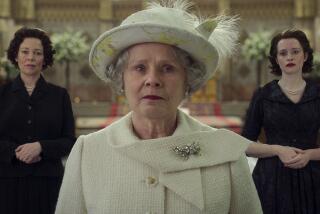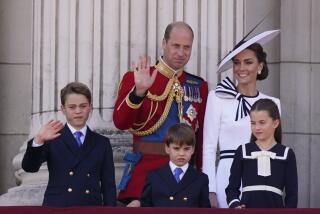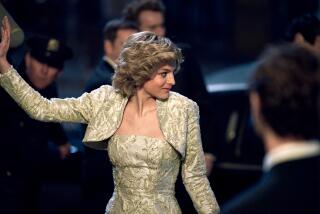Queen Mother, Britain’s Link to an Empire, Dies at 101
Queen Elizabeth the queen mother, whose relentless charm and iron will steered the British monarchy through a world war and an abdication crisis and into a modern age where its robes were sullied by embarrassing marital antics, died Saturday.
She was 101, the oldest member of Britain’s millennium-old monarchy, which has a history of short-lived men and long-lived women. Each successive birthday further exalted the “queen mum” as an ageless British fixture--the Rock of Gibraltar upholstered in pastel silk and crowned with a feathery hat.
As her husband, King George VI, did 50 years before, she died in her sleep. Her daughter, the queen, was with her “beloved mother” when she died at Royal Lodge, Windsor, at 3:15 on an English spring afternoon. Since Christmas, her health was complicated by a cough and chest infection, and her younger daughter, Margaret, had died seven weeks ago. A palace spokesman said her condition deteriorated suddenly Saturday. “It was a very moving and very sad moment, but luckily it was very peaceful,” Margaret Rhodes, the queen mother’s niece, told BBC television.
Prince Charles, said to be her favorite grandchild, was said to be “devastated” at the news. He and his sons, Princes William and Harry, were returning to London today from a ski holiday in Switzerland.
As with all senior royals, plans for the queen mother’s funeral--code-named “Tay Bridge” after a bridge in her Scottish homeland--have been in place for a long time, but her robust health kept defying the preparations.
Her body is to be taken to the Royal Chapel of All Saints in Windsor Great Park early today, where it is to lie in state for three days. The funeral will be held at Westminster Abbey, and she will be buried at Windsor. No precise schedule has been announced.
The queen mother’s life spanned the 19th, 20th and 21st centuries. Born in the reign of Queen Victoria, she married one of Victoria’s great-grandsons, before a soap opera drama made her queen of England and the last empress of India. She outlived her husband by half a century and lived to witness her elder daughter celebrate 50 years on the throne of an England much diminished in the queen mother’s lifetime.
News of the “queen mum’s” death spread on a quiet Easter weekend.
Scores of mourners, some bringing flowers, gathered outside Windsor Castle, about 20 miles west of London. The bells of a church nearby tolled to mark her death.
Small crowds gathered outside Buckingham Palace, where a death notice was posted on the black iron gates. The Union Jack flew at half-staff. As was done for Princess Margaret’s death in February and Princess Diana’s death in 1997, condolence books are to be opened for signing at St. James’s Palace today.
Prime Minister Tony Blair called her “a symbol of Britain’s decency and courage,” a woman possessed of “a profound sense of duty and service. She had this selfless devotion to duty. That’s what she believed in. That’s how she lived her life. And that’s how I hope she will be remembered.”
The archbishop of Canterbury, George Carey, said of her, “I loved her sense of fun and her interest in people. She had the common touch.”
The death of this living relic of an empire brought forth a wistful sorrow that lacked the shock of Diana’s death but instead arose from a country that seemed to be mourning not just the “queen mum” but the glory days of Britain itself.
Wartime Resolve Helped Unite Nation
The queen mother’s own Elizabethan Age spanned the 15 years that she was queen consort to King George VI. It began on the December day in 1936 that her husband’s elder brother, King Edward VIII, abdicated the throne to marry an American divorcee named Wallis Simpson. It ended in February 1952, when her husband died and her elder daughter, Elizabeth, became queen.
Over the years, the queen mother was handled with kid gloves even by the fickle British tabloid press, which can be fawning and carnivorous by turns, but her greatest compliment came from Adolf Hitler. The German Fuehrer, watching newsreels of her morale-building visits with bombed-out Britons during World War II, called her “the most dangerous woman in Europe.”
Her own wartime “charm offensive” is remembered in remarks of almost Churchillian resonance. When the Nazis added Buckingham Palace to their bombing targets, she was quoted as saying, “I’m glad we’ve been bombed. It makes me feel I can look the [blitzed] East End in the face.” And when thousands of London children were evacuated to safety in Canada and elsewhere, she declared famously, “The children won’t go without me, I won’t leave without the king, and the king will never leave.” (The children, the future Queen Elizabeth II and her sister, Princess Margaret, spent much of the war just outside London, at Windsor Castle, hidden away along with the crown jewels.)
She was diagnosed last year with anemia and had taken a number of falls over the years, in part from failing eyesight and perhaps in part because she insisted on wearing high heels to boost her 5-feet-nothing height. She had two hip replacements and cataract surgery, and underwent a colostomy in 1966--something the palace characterized delicately only as “major abdominal surgery.” When she choked on a fish bone in her 80s, the dedicated fisherwoman was quoted as calling the episode “the salmon’s revenge.”
If royal tombs had epitaphs, “charming” would be chiseled deep on Elizabeth’s. In her youth, platoons of men had fallen for her decorously flirtatious sex appeal. She was as delectably plump and fluffily attired as a bonbon in a frilled paper cup.
She was the life of the party, accomplished at singing, dancing and charades, and through her long public life as a royal, whether planting trees or cutting ribbons, she appeared to be enjoying herself enormously. All the more remarkable in the royal family, she had some modest intellectual interests, going to the theater, befriending the poetic Sitwells and hanging on her walls fairly modern paintings that had nothing to do with dead aristocrats.
To her people, she became the embodiment of great British virtues and small British vices. Had she been the grandmother down the street, as her humbler countrymen liked to think of her, her fondness for liquor and chocolates, for racetrack betting and horse breeding and for racy jokes would have gotten her labeled a bawdy old lady. People loved the tale of her calling down from an upper floor of her palace, wanting help from a doting household whose numbers included many homosexuals: “Are there any old queens down there who’ll fetch a gin and tonic for an old queen up here?”
A servant reported finding half-bitten chocolates in wastebaskets, where Elizabeth tossed them if the filling was not to her liking. On a tour of Manchester, a constable staring at her chewing something was startled when she opened her window and tossed him a caramel.
Loyalists Defended Her Against Critics
Long before Princess Diana, Elizabeth was the royal star, pioneer of the “royal common touch” and the now-standard “royal walkabout,” her magical chemistry elevating the ordinary to the regal. It was, a biographer wrote, “a splendid collusion, hoaxed and hoaxters indistinguishable from each other.”
Her critics, few but fierce, mocked her extravagances. Royal biographer Anthony Holden faulted her as “a woman who has never done a day’s work in her life, who has blithely run up eight-figure overdrafts of the taxpayers’ money on racehorses, had four palatial residences, 50 full-time servants and the pampered life of a latter-day Marie Antoinette.” Writer Will Self ridiculed the doting masses who loved her as one of them: “No, she hasn’t been ‘with us’; she’s been in the royal enclosure at Ascot.”
Naturally, legions of loyalists volunteered to horsewhip these cads. Taxpaying Britons who deplored the cut-ups of junior Windsors found their matriarch’s failings trivial and even adorable. When word leaked that this rich old lady had overdrawn her account by millions, people on pensions sent her checks. Her birthdays were elaborately celebrated; on her 80th, a squadron of jets flew overhead forming the letter “E,” and on her 100th, model Jerry Hall, garbed as a goddess, joined thousands of performers for a gala broadcast carried live and commercial-free.
If Southern women are steel magnolias, Scottish-born Elizabeth was steel heather. She was deeply traditional, and wished the royal genie could be put back in the bottle of privacy. Royal embarrassments were nothing new--one of her princely brothers-in-law was a drug addict and bisexual, and two of her nieces long listed as dead turned up alive in the 1980s, stashed in a mental asylum. But letting private matters become public, as Princess Diana regularly did, was regarded as at least an equal offense.
Elizabeth was born Aug. 4, 1900, and this youngest daughter of an earl spent part of her charmed childhood in the Macbeth-haunted castle of Glamis. During the world war that ravaged her generation, Glamis set up a military hospital for convalescing officers, who fell for the small, sweet-natured earl’s daughter who wrote their letters and kept them amused.
She was quite a catch. A newspaper coyly and wrongly reported her engagement to the dashing Prince of Wales, heir to the throne. But it was the second-born prince who never expected or wanted to be king who persisted in courting Elizabeth until she agreed to marry him. She could not have known that the marriage that made her “Her Royal Highness the Duchess of York” would also make her the first commoner queen since Henry VIII’s last wife. (“Commoner” is a relative term; on England’s tight little island, it means only that Elizabeth was not born royal, but she was certainly a member in high standing of the even tighter little circle of the rank-and-titled.)
Possessed of that brilliant something--instinct or talent or both--that a PR firm would pay millions to own, Elizabeth knew unerringly how to fill the royal slippers. On her wedding day, she went to the altar without a bouquet; on her way up the aisle in Westminster Abbey, she laid her roses and white heather on the Tomb of the Unknown Warrior. She was quick with a diplomatic quip to defuse difficult moments. On a South Africa visit, a Boer told her, “I’m sorry, but I really hate the English.” The queen of England zinged back, “I do sympathize. You see, I’m Scots.”
Her prince was hot-tempered, nervous and knock-kneed, and she took him in hand. His stuttering, probably from being switched from left-handed to right, made courtiers regard him as poorly suited to public life. Elizabeth’s decision to take him to a speech therapist was as radical in the 1920s as Diana’s to seek out astrologers was 60 years later, to less happy results.
And what could not be changed could be ignored or avoided; the unofficial royal slogan was “Never complain, never explain.” Good timing found her stuck in bed with the flu during the chaos of Abdication Week, in December 1936, when her brother-in-law, King Edward VIII, gave up crown and empire for “the woman I love.” Elizabeth’s husband was king, and she was queen.
Elizabeth sailed grandly into the role, managing to be simultaneously regal and cozy. Lifelong acclaim did not blunt her implacable dislike for Wallis Simpson and those who took her side. Elizabeth regarded Simpson as a greedy adventuress whose ambitions had besmirched royal repute and forced the weight of kingship on Elizabeth’s own husband, killing him in his 50s. Against all custom and law, it was Elizabeth who is said to have insisted that Simpson not share her new husband’s royal status. In later years Elizabeth sent flowers to the ailing Simpson, but in 1986 she might have gleaned some satisfaction from seeing Simpson buried without the word “royal” on her gravestone.
And yet Elizabeth’s daughter Margaret, who was pressured not to marry her first love, a divorced man, ended up divorcing the man she did marry. So would three of Elizabeth’s six grandchildren. She refused to meet Prince Charles’ lover, Camilla Parker Bowles, and was said to have been promised that Charles would not marry her while the queen mother lived.
Britain’s royal family survived where other royal families failed by pulling off the knife-edge act of seeming like a nice middle-class family that just happens to wear diamonds and dine from gold plate. World War II was the proving of it. The king and queen, who had at first favored appeasing Hitler, led the British empire to war. Steel-shuttered Buckingham Palace famously went on the same fuel and food cutbacks as Yorkshire cottages (although royal forests and farms and cellars supplemented the meagerness).
Public’s Love Bordered on Idolatry
Elizabeth endeared herself with such gestures as stopping on her way to a bomb shelter to pet a cat, and turning around the camera for a child who was holding it the wrong way. Her reward was love bordering on idolatry, beginning with her husband, who regarded her as “the most marvelous person.”
At a maternity ward visit, the queen asked anxiously about one patient in obvious distress, and was told, “She’s in advanced labor, but she will not go into the labor ward until she has seen the queen.” Only rarely was there a break in the smile, such as the brief newsreel footage of an “expression of distaste” as she moved through what a biographer described as “a group of dejected and no doubt smelly citizens” after an air raid.
In marriage, Elizabeth wanted to replicate her own happy family life, and her husband wanted to enjoy one that he had never had. Bookish they were not. Both indulged their daughters, especially their academic chores, and one nobleman observed, “I do not think she has altogether brought up her daughters in a way that has fitted them for the job they have to do.”
King George VI died of lung cancer in February 1952. Widowhood demoted her from the throne, but she was not upstaged, not even by her shy daughter, who was now the queen.
The royal equivalent of work--ribbon-cuttings, dedications, unveilings--brought her back to public life from deep mourning, and Elizabeth soon turned her sunrise smile on every besuited official, every little girl with a clutch of posies.
In the 1950s and ‘60s, as the sun set with regularity on a shrinking British realm, she became her daughter’s most personable ambassador, journeying to political hot spots such as Rhodesia, the Middle East, Northern Ireland, and less perilous destinations such as the United States and the Caribbean. Like a brilliant one-woman theatrical show, her meticulously choreographed appearances left behind eternally uncritical admirers.
At her own private dinners, the widowed queen could cut loose, instituting “anti-toasts” to those she disliked: a left-wing politician, Ugandan strongman Idi Amin, and former President Carter, reportedly “because he is the only man, since my dear husband died, to have had the effrontery to kiss me on the lips.”
As her age crept toward 100, her relatives, friends and courtiers began dying around her. When a lady-in-waiting pleaded that she felt too old for the job, Elizabeth demanded of her, “What about me?”
*
Times London Bureau Chief Marjorie Miller contributed to this report.
More to Read
Sign up for Essential California
The most important California stories and recommendations in your inbox every morning.
You may occasionally receive promotional content from the Los Angeles Times.











